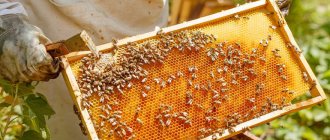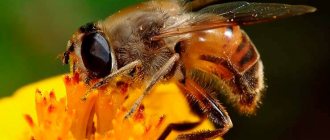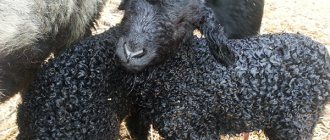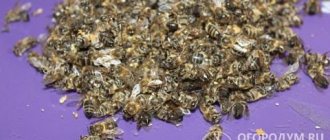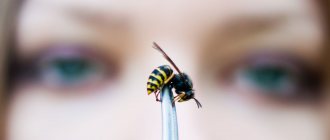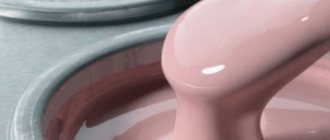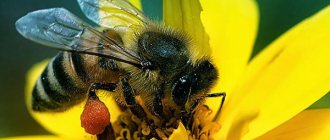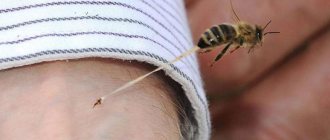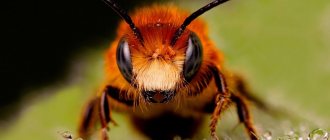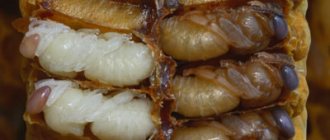Almost every person who has thought about the life of bees in one way or another wants to know where a bee gets its wax. Indeed, this is an interesting question, because wax by its nature is a unique substance and cannot be found almost anywhere. Before you find out where bees get wax to build honeycombs, you should turn to biology and learn about the structure of the body of bees. Today we will talk about the construction of wax honeycombs by bees. Read the following article on the pages of the magazine and you will find out where bees get wax for their honeycombs.
Physico-chemical parameters and composition
Wax is a unique biologically active product of complex chemical composition, and the secret of its appearance is known only to bees, which humanity has not yet been able to recreate artificially.
Color. The original substance produced by the bee has a transparent structure. Wax made from special raw materials is almost opaque and has a color ranging from white to various yellow varieties. The specific shade depends on the impurities and type of pigments:
- propolis gives a greenish-yellow color;
- natural yellow tones are provided by carotenoids;
- iron oxide colors the substance in brownish tones;
- brass colors the bee product bright yellow;
- copper impurities give the component a green tint;
- nickel makes the api product grayish-yellow;
- zinc colors the substance dark gray.
In order to get 1 kg of wax, bees eat 3.6 kg of fresh honey and some pollen. Bees seal cells with honey with wax and build honeycombs from it.
When exposed to sunlight, the substance becomes lighter.
Smell. It has the aroma of honey collected from a certain type of flower stalk. Smells slightly of propolis. The extracted and industrial product has a specific odor.
Taste. Does not have a pronounced taste.
State of aggregation. At room temperature it is a solid. At 20⁰С (and below) it becomes brittle and elastic-plastic. At 35⁰С (or more) the plastic substance softens.
Melting point – from 60⁰С to 70⁰С. After the temperature rises to 90⁰С – 100⁰С, moisture is removed from the wax. The decomposition of the product begins at 140⁰С – 150⁰С.
Beeswax is a complex mixture consisting of more than 300 chemical compounds.
Solubility. The api product is insoluble in aqueous media and glycerol. Partially soluble in gasoline, acetone and some alcohols. Completely dissolves in the presence of fats when heated above 30⁰C.
Compound. Includes about 50 chemical compounds, including:
- esters (melissil alcohol and palmitic acid);
- free fatty acids (cerotinic, neocerotinic, lemon balm, montanic);
- polyhydric alcohols;
- alkanes (or saturated hydrocarbons);
- coloring matter (lutein, cerochromatin, chrysin);
- antibacterial components;
- carotenoids;
- aromatics;
- water.
The benefits and harms of wax
The wax contains pollen, propolis, minerals and vitamins, which are not destroyed even after overheating.
The beneficial properties of bee products include:
- plastic;
- regulation of the state of aggregation using accessible methods;
- antibacterial and protective;
- naturalness;
- availability;
- unpretentiousness in storage;
- maintaining quality for a long time;
- special chemical and organoleptic properties;
- safety (registered as food additive E901).
Wax is the richest source of provitamin A: 100 g of wax contains about 4 g, while 100 g of carrots contains only 0.01 g.
Scientists have calculated that wax contains 80 times more provitamin A than beef. Disadvantages of wax:
- allergen content (like all bee products, wax can cause allergic reactions);
- the ability to accumulate poison - thymol (used when processing the hive);
- limited quantity (meaning natural bee product);
- seasonality of collection (summer - autumn);
- dependence on diseases (wax is not collected when the hive is infected with varroa);
- the need for veterinary control of raw materials.
Other Applications
- Cheese production uses wax to coat fermented milk products in order to protect them from excessive loss of moisture and loss of taste;
- Furniture and parquet industries use wax as a natural polishing material;
- Used for making candles, mastics, lubricants;
- In the cosmetology industry, wax is used to make natural cosmetics;
- Beekeepers use foundation to make foundation;
- In foundries, wax is used to make molds for subsequent casting.
Where do bees get wax?
Did you know that nowadays even candies containing wax are produced.
Chewing them enhances the production of saliva and gastric juice and thereby promotes good digestion and strengthens gums and teeth. Many beekeepers believe that hive insects produce auxiliary products using collected honey as a raw material. This is not entirely true. So, where do bees get honeycomb wax from?
The plastic yellowish material is the result of a bee’s life. How do bees make wax? Winged insects produce the substance using special wax glands that secrete a viscous, colorless secretion.
The production of the required component is assigned by nature to working females. The substance appears on the surface in the form of whitish plates on the abdomen.
Wax is added to sunscreens for the skin, emulsions and balms to treat burns.
The bee begins to produce cellular wax at the age of 12 – 18 days. Most of the substance is produced by young individuals. The ability to produce a product is considered one of the key characteristics of the breed.
It is believed that there is a direct relationship between the size of wax glands and the rate of production of the substance. There is no loss of wax: bees of any breed produce a product, so each bee’s home contains some amount of the wax component.
Medicinal properties
Beeswax is successfully used in the treatment of the following diseases:
- Peptic ulcer;
- Burns;
- Wounds;
- Diseases of the upper respiratory tract (tonsillitis, laryngitis, pharyngitis, gingivitis, sinusitis, sinusitis, otitis, rhinitis, tracheitis, bronchitis and others);
- Dysbacteriosis;
- Dental problems (plaque, periodontitis, periodontal disease, stomatitis);
- Gynecological diseases;
- Joint diseases;
- Age-related skin changes, loss of elasticity, wrinkles;
- Acne, teenage rash;
- Warts, calluses, corns.
What ingredients is the substance made from?
A traditional medicine recipe is to chew wax to stop smoking.
The insect fills the crop with nectar, after which the sweet flower juice is filtered in the mouthparts. The purified nectar is sent to the address cell, and the result of filtration (pollen particles) is used as feedstock for wax production. Accordingly, the better the honey bribe, the more wax the winged workers can produce.
To produce wax, bees use only the pollen that enters the body along with nectar. Particles of the plant component that stick to the “coat” are cleaned off using foot brushes and later used to make beebread.
Beneficial features
- Bactericidal. Wax is used to relieve inflammatory processes, for speedy recovery from thermal damage and wounds of the skin, mucous membrane, and peptic ulcer;
- Adsorbent. Cleanses the body of toxins and waste;
- Regenerating. Promotes accelerated tissue restoration;
- Normalizes the activity of the gastrointestinal tract;
- Regulates the amount of beneficial intestinal microflora;
- Slows down the aging process;
- Activates metabolism;
- Improves intestinal motility;
- Natural antibiotic;
- Pain reliever;
- Slowly releases heat (this property is used in wax compresses);
- Improves blood supply to problem areas.
Successfully used in cosmetology:
- Strengthens nail plates;
- Helps get rid of age and expression wrinkles;
- Helps hair become more manageable, soft, shiny and voluminous;
- Used in the treatment of split ends of hair;
- Hairdressers widely use wax to style hair;
- Cleanses the skin, helps in the treatment of problem skin in adolescents;
- Used for depilation.
How bees make wax honeycombs
The first mention of the use of wax as a medicine is contained in the Egyptian “Ebers Papyrus,” dating back to 1700 BC.
The hexagonal cells that make up the “bee kingdom” are constructed by workers from a special type of wax that insects produce shortly after waking up from hibernation.
To build honeycombs, you need a suitable temperature (about 35⁰C), at which the required consistency and plasticity of the wax “building material” is maintained. The correct temperature conditions allow you to construct cells of the ideal shape and desired size.
Despite the fact that flower nectar is needed to accumulate raw materials in the body, the family begins building honeycombs in early spring - before the bees go for the first bribe. The construction of cells is an important part of preparing for the season.
Interesting to know. Many ancient doctors, including Hippocrates, recommended applying warm wax to the head and neck of a patient with a sore throat. In the Middle Ages, wax, along with honey, was used to prepare various medicinal products.
The team has “builders” of different specialties, and each bee is responsible for its own area of work: the foundation is laid separately, after which the bridges are formed and the honeycombs are built. The finished structure is additionally polished to a shine. During the construction process, insects build honeycombs, moving from top to bottom - from the roof to the floor.
Finished honeycombs are “maintained” in a special way - those infected with mold are cleaned and disinfected, and damaged ones are restored.
The process itself looks like this:
The wax-producing workers hang inside the hive near the ceiling. The insect's head is directed upward, and a lower “drummer” is attached to the hind legs, which takes part in the construction of honeycombs. A chain of bees is formed.
Did you know that before the invention of paper, letters were written on flat wooden boards coated on one side with an even layer of wax. They used a special metal stick with a pointed end to write like a pen; and with its blunt end, if necessary, smoothed out the scribbled surface.
As soon as a viscous substance emerges from the glands, the bee leaves its “post” in the chain and crawls up. The plates of transparent substance are captured by the paws and crushed in the oral apparatus, where the wax is moistened with saliva.
The resulting mixture is spread in small portions onto the work surface, gradually forming a hexagon.
If a mediastinum has already been formed on a base (for example, foundation) - a natural or artificially created first cell, then the honeycombs are built in two directions from the initial hexagon.
All combs, except queen cells, have a standard size - about 5.7 mm in diameter and 12 mm in depth. Queen cells are larger - about 10 mm and are needed for the queen to lay eggs or hatch a new queen.
Why do bees need wax?
Interesting to know.
For many centuries, artists used wax-based paints: they had both extraordinary durability and remarkable shine. And although now the latest technologies have seriously displaced wax painting, wax still serves as the most important element of oil paints. Bees use wax to build honeycombs - special hexagonal cells of four types. Hexagons are classified by purpose:
- bee (for brood, storage of honey and bee bread);
- honey (in the upper and side parts of the section);
- drones;
- queen cells (for breeding queen bees).
Since wax has bactericidal, antifungal and antiviral properties, unripe honey placed in the holes does not ferment or mold.
Where and how is beeswax used?
About 5,000 years ago, the secret of making encaustic paints using wax was discovered. Paintings painted with such paints have survived to this day.
Beekeeping
From wax raw materials, foundation is produced - small plates that form the basis for the construction of honeycombs and speed up the construction process.
Medicine
In therapy and pharmaceuticals, the antibacterial, antifungal and anti-inflammatory properties of the component are valued: wax is used as a lipid base or emulsifier in the production of plasters, suppositories, creams, ointments, suspensions and mastics. The so-called dental wax has become widespread.
Cosmetology
Interesting to know.
In the Middle Ages, wax, along with honey, was used to prepare various medicinal products. In the “Canon of Medical Science,” the famous ancient Arab scientist Avicenna proposed using wax in many of his medicinal recipes. Wax is used as a fatty base and emulsifier in the manufacture of lipsticks, solid perfumes, creams and ointments. Due to its special thermal properties, the material is used for hair removal.
Metallurgy and jewelry making
Lost wax models and casting molds are made from wax.
Caring for furniture and art objects
A wax protective film is applied to marble statues. Furniture and parquet made of natural wood are treated with wax mastic.
Food industry
Any products and products prepared with the addition of components of bee activity should be used only if there are no contraindications.
The bee product is registered as a food additive and is widely used in the food industry. In particular, the surface of hard cheeses is protected with a wax film.
There are still irreplaceable ones!
Even the ancient Greeks made wax dolls for children, and used wax-coated tablets for writing. They added melted wax to the paints and covered the sides of ships while hot to protect the wood from wind, water and sun. Amphoras with food were sealed with beeswax. Beeswax was used by artists; it was in Greece that encaustic, which is still popular today, was developed - wax painting.
Ancient doctors, including Hippocrates and Avicenna, used beeswax to treat patients. Where is beeswax used today?
- A large amount of beeswax, about 70%, is returned back to the beekeeping industry in the form of artificial wax. Foundation is wax sheets with hexagons extruded on them - the bottoms of the cells, attached to the hive and used by bees to build honeycombs.
- In medicine, wax is added to ointments, suppositories, and emulsions to treat skin inflammation, burns, and wounds.
- In cosmetology, creams, masks, and lipsticks are made using beeswax.
Wax is also widely used in optical factories, railway transport, electrical engineering, woodworking, automotive, glass, and textile industries.
From bees, people get not only honey, propolis, bee bread, but also other unique products, such as wax. This is not a waste product from bee production, as many people think. It is needed not only for the insects themselves, but is also widely used by people.
